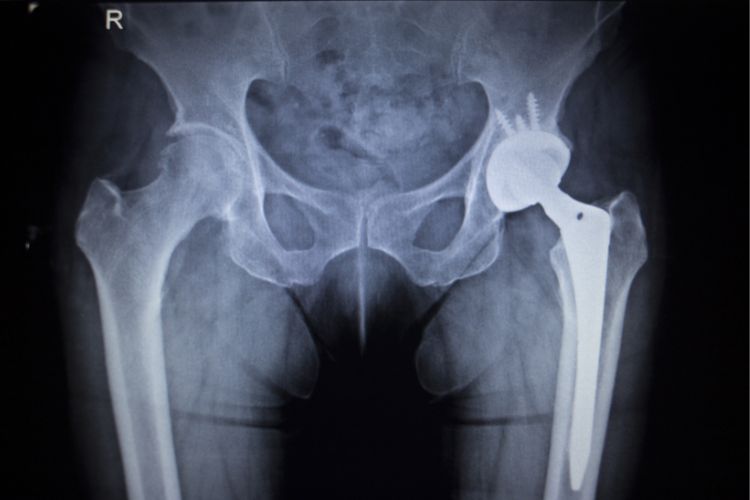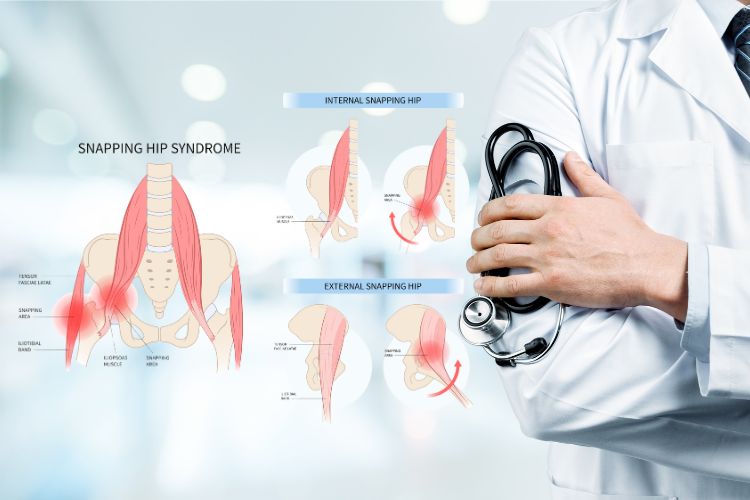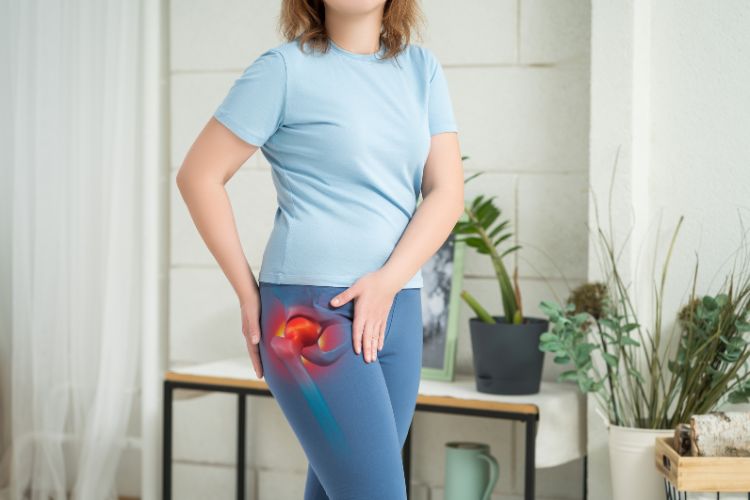It is estimated that bursitis after hip replacement occurs in 3 to 17 percent of the population, causing chronic pain and significantly impacting the quality of life of the patient. Bursitis occurs when the small pads between the joints and tendons called bursa become inflamed. Bursae sacs are found in many joints, including the knees, elbows, shoulders, and hips. After a hip replacement, it is not uncommon for inflammation to occur in the fluid-filled sacs between the hip joints and the tendons of the hip.
Bursitis of the hip can cause knee pain and back pain, as the pain causes an altered gait that could trigger pain in other parts of the body. It happens when impact to the bursa sacs occurs repeatedly and causes injury and inflammation. Knowing that bursitis, after hip replacement can happen, is part of a good prevention plan to avoid this problem. Learn more about bursitis after hip replacement here.
Understanding Bursitis
The bursae sacs in the body are sacs filled with a jelly-like fluid that serve as cushions or pillows when impacts are felt in the joints. Impacts could include anything from a fall to everyday walking. Their function is to reduce and prevent friction between the joints so that the joints and their surrounding tissues stay healthy. When these sacs begin to wear down or experience inflammation, a painful condition known as bursitis occurs.
The bursa of the hip joint can become inflamed as a natural process of aging. After a hip replacement, the bursa covering the bony section of the hip bone can become stiff and sore and make walking painful. In the hip, there are multiple locations for these bursae, over the joint, and around the interior section of the groin next to the hip. The pain can radiate throughout the entire pelvic region after hip surgery.
Bursitis in the hip after hip replacement feels like a burning pain throughout the entire hip region, but specifically around the hip. The pain can range from mild pain to a sharp and burning sensation that is characterized as being intense. The pain can grow and spread across the entire hip if the bursitis is not treated. Patients with bursitis after hip replacement will find the pain worsens with mobility and movements such as climbing, squatting, and even walking.

Causes of Bursitis After Hip Replacement
Many different factors contribute to bursitis after a hip replacement. Recovery from a hip replacement can be a lengthy and arduous process, and complications like bursitis can make it worse. If you have recently undergone hip surgery, you will want to follow your doctor’s instructions carefully to prevent bursitis. You’ll want to avoid anything that causes an impact on your joints and the surrounding tissues.
Activities that create repetitive stress around the bursa sacs can cause or exacerbate bursitis. Walking on a treadmill or riding a bike are examples of activities that cause repetitive stress to the bursa sacs in the body. An additional injury to the site of your surgery can also inflame the bursa and cause bursitis after hip replacement. You’ll also want to be careful how you sleep when you have bursitis or are trying to avoid it.
Sleeping on one side of the body will have a great impact on the bursa sacs on the hip joint you are sleeping on. You could also injure the bursa if you lie on one side of your body for long periods, such as watching television or relaxing on the couch. Other conditions such as rheumatoid arthritis will also impact the bursa sacs, and you may find inflammation feels worse with bursitis when you have rheumatoid arthritis. For people who have one leg that is slightly shorter than the other, bursitis is a common condition that can be worsened with hip replacement.
People who have had previous hip surgery will also be at a greater risk of bursitis after hip surgery. Any kind of surgery in this area will increase the risk of inflamed bursa which could result in bursitis. Poor posture could be a temporary outcome of hip surgery, but could also be a cause of bursitis. The additional weight of your posture places pressure on the joints.
The outcome is an inflamed bursa and the painful condition of bursitis. Many different factors could contribute to bursitis after hip surgery. You’ll want to take your time during recovery to get back to low-impact movement, while still staying mobile enough to get your hip back to everyday life.

Symptoms and Early Recognition
When you are wondering what bursitis in the hip feels like, the most common symptoms are burning sensations and pain. You’ll find these sensations on the outside of the hip and the inside of your leg in the upper thigh. Some bursitis symptoms will also radiate towards your back and around your buttocks. You may find that you feel pain after sitting for a long period as well.
This pain will be a different kind of pain that is a little worse than the stiffness you find when sitting for an extended period. In addition to stiffness, you may feel a burning or intense shooting pain around the joints. Bursitis pain after hip surgery can be very difficult to deal with, and you may also have anxiety and some depression from coping with extended pain. Talk to your doctor if you notice anything unusual about your pain levels after hip surgery.
Prevention Strategies
There may be a few adjustments to your lifestyle after hip surgery, but many of them will be enjoyable. In most cases, a hip replacement follows an extended period of pain and mobility issues that make it difficult to enjoy life. You can prevent bursitis after your surgery by staying active, but moderating your activities so that you do not put too much impact on your bursa sacs. You want to watch your posture and not overdo any activities that impact your hips.
If you are doing activities that impact your hips, make sure that you take regular breaks in between. Don’t jump into exercise if you are already in pain, and ease into any major change of life where activity around your hips is concerned. You also want to watch your sleeping habits so that you don’t impact your joints or cause inflammation and pain in your bursa. Rest and low activity levels will help to keep bursitis at bay after hip surgery.
Treatment Options
If you are dealing with bursitis after hip replacement, there are different things that you can do to treat the pain. You’ll want to modify your activity immediately or cut impact exercise or movement out of your day altogether until you are healed. Medications such as non-steroidal anti-inflammatories will help. Medications such as ibuprofen or naproxen are often available over the counter, but your doctor may be able to prescribe you stronger anti-inflammatories for severe pain.
As important as it is to limit your exercise, your doctor may also prescribe physical therapy for you. Some exercises can help you to cope with the pain of bursitis, or a therapist can help you to learn them as well. You’ll want to get into the habit of stretching your hip muscles and use massage and heat when bursitis flares up after your hip replacement. In extreme cases, when bursitis can’t heal on its own, additional surgery may be necessary to remove the bursa if the inflammation gets too severe.
Post-Surgery Rehabilitation
There are many different ways to get back into life after hip surgery. You’ll want to undergo different kinds of physical therapy to ensure that your hip surgery heals properly. The most important step in healing after hip replacement and preventing bursitis is to avoid any activity on the joints that would be considered a high-impact activity. Anything repetitive in nature will stress your hips and increase your risk of bursitis.
For most hip surgeries, it takes anywhere from six to 10 weeks to heal and fully recover from the surgery. It could take longer if you are also dealing with bursitis. You will want to stay active without engaging in repetitive activities that cause pain. Make sure that you have the right footwear after hip surgery so that your feet feel comfortable when you are walking.
Bursitis after hip replacement shouldn’t interfere with your quality of life too much. You simply need to take some extra precautions to avoid repetitive impact on your hips. You can shower and work and live your life like normal. You want to take additional care of your hips and use canes, crutches, and walkers when you can to avoid causing additional problems like bursitis.
Prevent Bursitis Today
When you have had a hip replacement, you may become at risk of bursitis. This inflammation around the joints will cause additional problems during your recovery. Walking is good for hip bursitis and so are many other low-impact activities. Hip bursitis should not last longer than a few weeks, and will go away with time, rest, and attention to the impact of activities on your hip.
